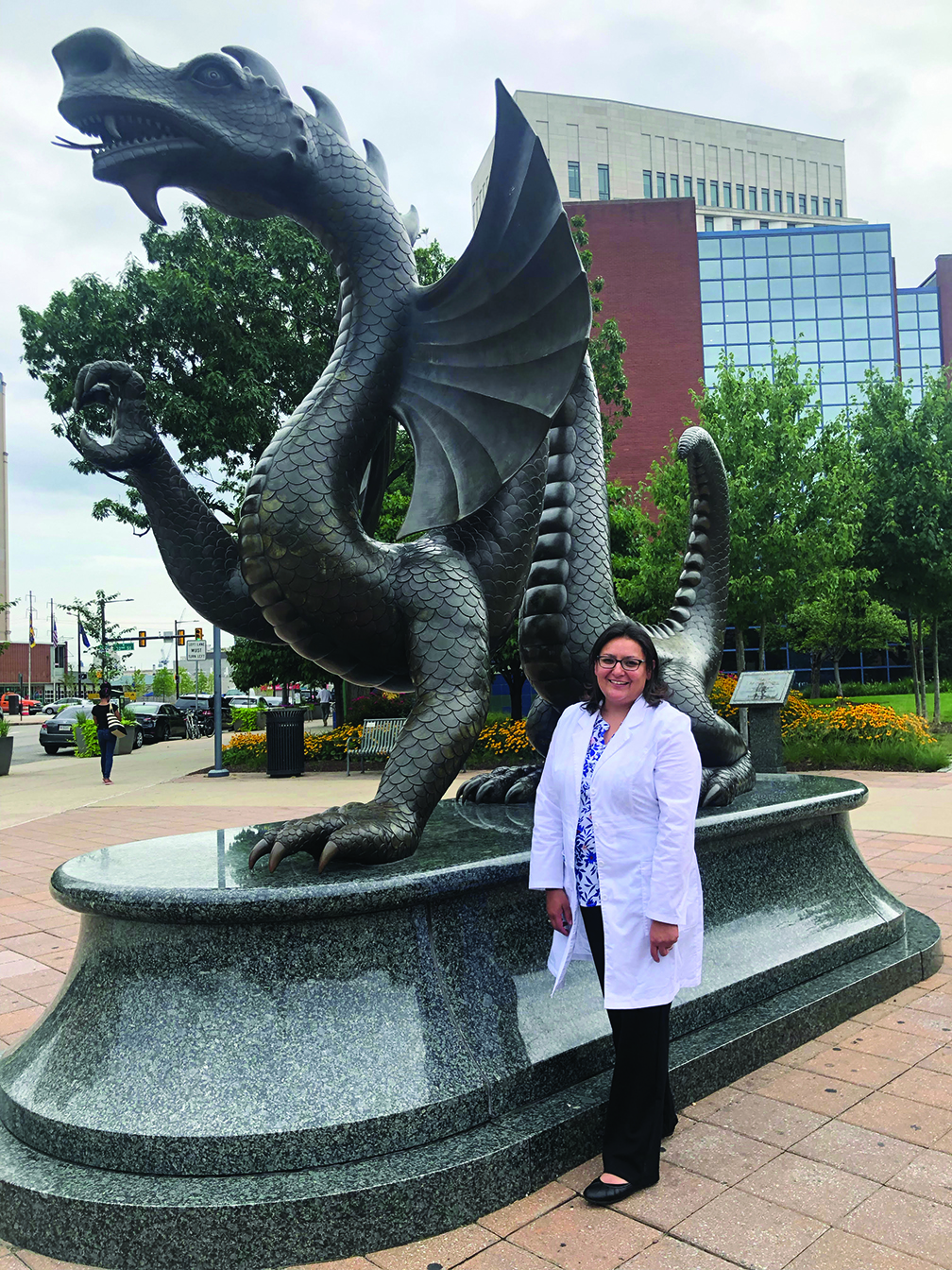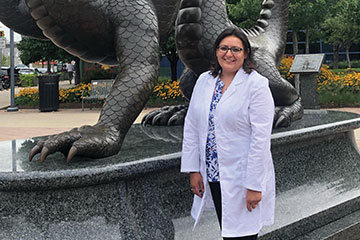There have been ups and downs in the nine months since the COVID-19 pandemic hit the United States in earnest, yet with every fluctuation of the virus’ trendline, healthcare professionals around the nation have stood firm, serving their communities with dedication and determination.
Avir Mitra, MD ’15, and Sara Bonanini, MSN ’20, are two such healthcare heroes working on the frontlines of the pandemic in very different environments. Mitra is an emergency medicine doctor in New York City, the country’s first COVID-19 hotspot, and Bonanini is an emergency department nurse on the Crow Indian Reservation south of Billings, Montana.
Throughout the pandemic, and as it continues to unfold, these recent Drexel graduates have proven that collaboration, adaptability and strong commitment to community can make meaningful differences in trying times.

Avir Mitra, ’15
New York City
Mitra and others in the emergency room (ER) at Mount Sinai Beth Israel Hospital in New York City were probably unknowingly seeing patients with COVID-19 back in February, and perhaps even as early as January, but the virus wasn’t then top of mind. Mitra, who is assistant professor at the Icahn School of Medicine and clerkship site director for Emergency Medicine at Mount Sinai Beth Israel, remembers vividly the first positive test he ran.
“It really shook me, and the pandemic started to feel very real,” says Mitra. “We had already been seeing patients in the emergency room who had traveled to high-risk countries. I remember thinking their symptoms had to be related to COVID-19, but we didn’t yet have a test. I remember thinking that COVID-19 might be everywhere and we just didn’t know it. And then after we finally had swabs to start testing, cases really started to rise.”
Recalling those early days Mitra continues, “It felt like the ground was falling out from under us. We didn’t have the tests or the treatments we needed. We didn’t have enough PPE [personal protective equipment], so we were reusing one mask for the week. Then all of a sudden, it was like every other problem disappeared — no heart attacks, no strokes, no appendicitis. The ER was overrun with COVID-19 cases.”
Over time, Mitra and his colleagues learned a lot about the virus and developed new protocols. Says Mitra, “By early May, in some ways I felt like we knew what we were dealing with, we had process- es in place, and all that helped my colleagues and I better cope with the situation.”
Collaborations kicked into high gear. “We started to figure out tools and tricks that seemed to be working, and we spread this information among each other through WhatsApp messaging groups and blog posts. On YouTube, doctors in different cities would post videos of their ideas; we would try them and vice versa. These makeshift communities emerged and this sharing and making use of new ideas was all happening in real time. I had never seen that before.”
It’s difficult for Mitra to take stock of all that he’s experienced. “This pandemic has changed me,” he reflects. “It’s still changing me, and I’m trying to figure that out.”
“It felt like the ground was falling out from under us. The ER was overrun with COVID-19 cases.”
– Avir Mitra
He says he knows a couple of things for certain: “I always took my job seriously, but now I feel that sense of seriousness in a much more profound way. And now more than ever, I realize the importance of systems. Being a good doctor is important, of course, but we also need healthcare systems that work well so we can respond quickly and deliver good care.”
Mitra wasn’t surprised to see another surge in the fall, but this time everyone is prepared. “We have the facilities we need,” he says. “I’m not so worried about running out of ventilators. In fact, we’ve figured out that putting everyone on a ventilator isn’t the answer, and we’ve discovered better ways of treating patients. We understand the disease a lot better.”
Concludes Mitra, “I feel proud of how New York has managed this pandemic. Everyone is working together.”

Sara Bonanini ’20
Big Horn County, Montana
Across the country, on the Crow Indian Reservation near Billings, Montana, Sara Bonanini was watching the pandemic unfold on the news. Bonanini, who is supervisory clinical nurse of the Emergency Department at Northern Cheyenne Hospital, felt like she had a pretty good handle on the situation. “I remember telling our service unit here that we need to make sure we have enough staff and plenty of PPE because COVID-19 is eventually going to make its way here.”
Despite Montana’s low case rates throughout the spring, the Crow Reservation announced stay-at-home orders right away. Says Bonanini, “Tribal workers were posted at entrances to the reservation to limit unnecessary travel in and out.”
“We made certain adjustments early on,” continues Bonanini. “We limited open access to the hospital, so not everyone can just walk through. We’re having people wait in their cars and call into the ER, screening them and making sure they have masks before entering. We also bought some small sheds for outside the ER in case we needed triage areas, and once COVID-19 started hitting this area, we started using them as testing sites.”
Just as in New York City, collaboration has been key at the small hospital in Northern Cheyenne. Says Bonanini, “Our ER has eight beds, and we have only four permanent nurses and six contract nurses. As supervisor, I fill in when needed, even in ordinary times. Now working with other units is even more crucial. We had to prepare in case our little eight-bed ER got overwhelmed. We cross-trained nurses from other departments to come over to the ER if needed. There was also one week when people in other departments were out sick, so I was acting director of nursing and acting inpatient supervisor on top of my regular ER supervisor duties.”
Throughout the pandemic, adaptability has been important. “For us, a new service that has come out of the pandemic is telehealth,” says Bonanini. “It’s a more convenient way for people to access their primary care provider, especially here where it’s such a rural environment and patients may live an hour away.”
In early August, Big Horn County, where the Crow Reservation is located, experienced a surge in COVID-19 cases and had the highest number of cases per capita in Montana. Bonanini feels the effects of that. She says, “I have my ups and downs. There are times when I go home and really feel the stress and pain of it all. We’ve had some deaths related to COVID-19, and it’s something that we’re all dealing with.”
“Every day, someone tells me, ‘Thank you for doing what you do!’ During this pandemic, this sense of community has been vital.” – Sara Bonanini
Around the country, COVID-19 has disproportionately affected Native Americans, who have been three-and-a-half times more likely than non-Hispanic Caucasians to test positive. Says Bonanini, “One of the factors here is that there are numerous multi-generational families living together. Once one person tests positive, it’s not unusual for the rest of the family to become positive. Native Americans are also known to have numerous underlying conditions and, therefore are experiencing higher rates of serious complications with coronavirus.”
Bonanini adds, “As a Native American myself, a member of the Blackfeet Nation, I’m really proud to be taking care of the Native-American population.”
“I try to remain positive,” says Bonanini. “I focus on the knowledge that I’m taking care of my community. In rural communities like this one, we all come together to help each other through tough times. Family, friends and neighbors are there for me and my colleagues when we need support and encouragement. Every day, someone tells me ‘Thank you for doing what you do!’ During this pandemic, this sense of community has been vital.”



